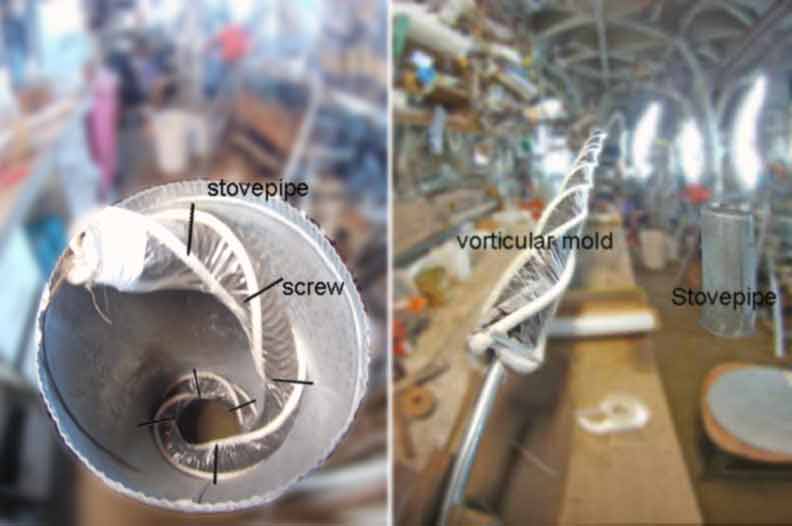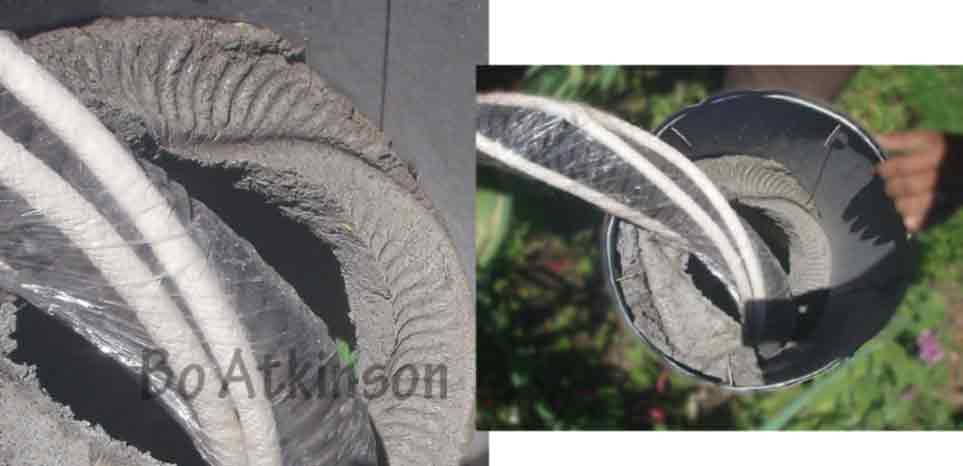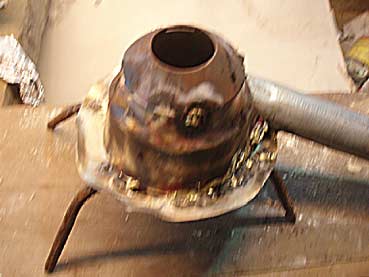
Simply stated, if outdoor temperatures are warmer than the chimney temperature, air might tend to flow down the chimney instead of up. This is terrible for starting old fashioned masonry stoves, which are hard to use before cold temperatures predominate. A significant updraft of air is needed for good fire starting conditions. Massive masonry heaters slow down the gradual warm up phase. A warm chimney is needed to eject the fire exhaust, and warming up a chimney during summer months is not expedient.
Therefore i tweaked the following experiment over several years. Which proved ineffective for creating updrafts in itself. I was surprised with stubborn failures. I had bought a surplus, high efficiency fan manufactured for large electronic equipment, which injected a considerable stream of air out of the chimney top. This fan took air from the chimney exterior, so as not to foul it's delicate turbo blades. The mechanical principles generally relate to Bernoulli' and Venturi tube effects.
Despite several efforts at tweaking some arrangement of this effect at the chimney top, my stove draft was not helpfully induced by this innovation. I built an inducer in my workshop first and then mounted it up the chimney. The failure to do this is due to too many other projects which take all my time, for the humble chores of life.
My first modification to this finding was that the vortical induction should proceed only from center and not from outer edges of the chimney. Therefore i inserted a center tube to test this idea. Initial observation provided no initial improvements. I still need to improve the air dynamics of my crude "air nozzles.
I previously detailed my construction of simple chimney section below. (I think this was all installed around 2013. in my large chimney). I consider my tests only preliminary.

The image above is an abbreviation of a remarkably well- hand- drawn- vorticular flow pattern. As Viktor visualized elements of his invention for water distribution, in specially modified pipes, (for plumbing). The helical aspects were deemed applicable to chimneys, to whirl the exhaust, and observe whether whirling induces draft.
Callum Coats has generously published several excellent books on Viktor Schauberger's works. (Web search these names for many details and for free download books). Much of Victor's work involves vortices, whirls, flows and natural mimicry applied to engineering. Have these structural concepts challenged the vested interests of commodified energy? Or will efficient wood burning become entirely obsolete in the future of mankind?
The next image below reveals my construction technique. (Backgrounds are especially blurred to conserve website bandwidth).This stovepipe section (about 1 meter or 3 feet in length), was constructed to be installed in the top of my home dome. It actually also included some insulating features in the final installation, not shown here. The following images focus on the swirl inducing structure and how to easily build it. Over the years, i have innovated many applications for molding Cementitious structure.

The mold components include a heavy rubber hose. (Type for expelling auto exhaust from a garage.) Ropes are wound around the hose and food plastic wraps these together. Then these can be loosely fit inside the stove pipe. In addition, holes are marked and later made for the screws. Finally all are positioned as seen to left, in photos above. The screws will anchor the cement which is hand molded into place, as seen in photos below.

The cement is revealed after the wrapped mold components are removed. The stove pipe thus receives a spiral shaped, fixed position, cement vane structure. This vane is intended to induce spiraling flows. Next photo below shows an additional whirl inducer- This inducer, (patch worked and welded together), is fed blower air in case the entire chimney structure happens to have been cooler than outdoor temperatures- Which happens occasionally, before winter starts, when fires are little needed. This chimney is part of a complex masonry heater. I was just upgrading this top portion this Autumn 2013.

The draft in my masonry chimney is overly strong in cold weather, but when outdoor temperatures are not cold enough, the draft is too weak to start a fire. This condition occurs only "off season", before very cold weather sets in and is not troublesome. However the opportunity to test draft induction was found with a bargain-price fan of high efficiency, to supercharge the spiral vane chimney concept.
A necessary feature of this blower addition to the draft was to easily isolate the blower from the exhaust, (stop the fan), and to avoid fouling of blower parts, (the turbine style fan blades). The highly efficient surplus blower made for computers cannot be exposed to combustion exhaust, hence the word 'induction'. For charcoal style of burning, an especially high draft is needed for cold starts and low drafts are needed for long slow charcoal burning. Summer time use would need highly adjustable controls, which added promise and which roused action.
After all the planning and earnest construction, the testing began: The draft induction fan made no difference in the draft, which was surprising. Otherwise the draft works the same as it did, without the fan addition. Installation was done from the top of chimney, which was difficult and time ran out. This project might again be modified by cutting a side hole into chimney, to access the blower and to modify the low-power-blower-dynamics, and possibly correct it's functionality, (which is useful when outdoor temperatures are higher than indoor temperatures). The delicate fan is safe inside the attic, waiting for this possible reattempt.
I always tried to combine art, science and philosophy as one occupation. This was not marketable, but it did enable self-sufficient methods of living, with seasonal jobs to pay expenses, and also to recycle scrapped materials as much as possible, in the plentiful free time of the back woods. The all- demolishing powers of our world have always corrupted and crashed the progress of mankind, which is a fact almost unknown to the average person. A workable solution was dreaming up a "ship wrecked romance of life", trying to rebuild with the broken pieces, and this provided a new found freedom.
![]()
My pictorial, website index is here.
Here are some links on my website relating to double and multi spiral modeling experiments.
Envisaging Transverse Force Fields: Laminated, parallel coils are considered on this linked page.
geometric speculation: poloidal
coil structure.
biaxial potential for habitable buildings.
InductiveCouplingGeometry.html
Reflex-Vortex-Interleaved.html